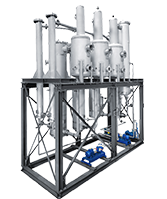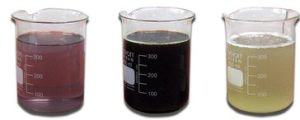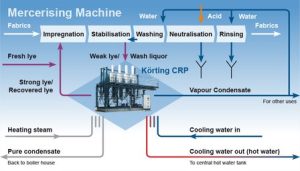Caustic Recovery Plants
Caustic Recovery Plants for the Textil Industry
Mercerisation is a finishing process in the textile industry where the textile fibers are treated under tensile stress with caustic soda. Large quantities of diluted caustic soda (weak lye) are a waste product of this process. Körting Caustic Recovery Plants (CRPs) can turn a very large proportion of this weak lye into reusable concentrated caustic soda (strong lye). Körting Hannover AG has been on the market longer than any other manufacturers in this field and is the global market leader of CRPs.
Advantages of Körting plants
- global market leader in CRP technology
- used caustic soda (weak lye) can be recovered
- recovered strong lye can be cleaned with hydrogen peroxide
- quality of the vapour condensate is excellent because swirl droplet separators are used
- vapour condensate has a low pH-value(can be used in other processes, e.g. washing in the mercerising machine, bleaching)
- the plant is highly energy efficient(the hot water generated is used)
- sustainability in the mercerisation process
- return on investment less than one year
- in-depth experience: since 1956 more than 200 Körting plants installed in more than 50 countries
Sustainability and quick return on investment
Sustainability has become an important goal, particularly for many companies in the textile industry. Körting technology allows textile companies to introduce sustainability into the mercerisation process. Due to the recovery process, the plant operator doesn’t have to bother disposing of the weak lye. The environment benefits directly, because the lye can be reused. Savings of one million euros and more per year are possible. The CRP can have a return on investment within one year. As a result, plant operators can permanently cut the overheads incurred from mercerization. When designing the plant, Körting engineers already include the savings potential in the calculation.
Körting CRPs are not just limited to white bleached fabrics. They can also be used for yarn-dyed and denim fabrics.
In the 1950s, Körting engineers developed the first CRP for textile processes. The first CRP was commissioned back in 1956. Over the past almost 60 years, over 200 plants have gone into operation in more than 50 countries. Across the world plant operators place their trust in the experience and reliability of Körting plants. Quality made in Germany isn’t just sought after in Europe, but also in the world’s up-and-coming textile nations. No other company has been involved in manufacturing CRP for as long as Körting Hannover AG.



